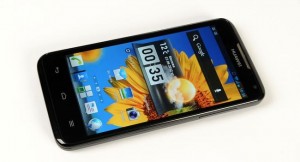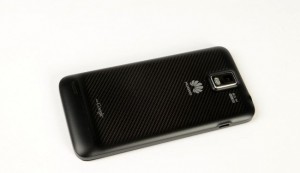When you have two identical phones, one of which operates at a quad-core production Hi-Silicon – Huawei K3V2, and the second on a well-proven dual-core TI OMAP 4460, the right choice is not so easy. First bribes theoretical capacity, the second – the price. To understand whether or not to wait for a more powerful version, we have brought you the review of model on dual-core processor TI – Huawei Ascend D1 which will guide you throw its ups and down and will help you to choose that you should buy this phone or not.
Design of Huawei Ascend D1 smartphone is hardly unique, or at least one that all its views clearly says about who its manufacturer. Housing is compact enough and may compete in this parameter with devices equipped with a screen diagonal of 4.3″, the Ascend D1 display has a diagonal of 4.5″. Although Huawei has never claimed to record a thin frame around the screen, its size is comparable to the Samsung Galaxy Nexus and less than the LG Optimus True HD, which is a good thing.
Corners of the Huawei Ascend D1 are rounded, while the sides and ends of the flat. Round tempered glass on the front of the device used glossy plastic. For additional protection, glass plastic, bordering it, a little above the surface of the housing.
At the top of the front panel: metal mesh speaker, status display, proximity and ambient light, as well as HD-eye camera.
Below the display are three touch-sensitive keys, and barely noticeable mic hole at the interface between the glass and the plastic.
Despite the fact that the earlier glass Gorilla Glass for smartphones, Huawei has not been applied, the Huawei Ascend D1 uses tempered glass is Corning.
At the top end of Huawei Ascend D1 there is only 3.5 mm jack and power button / lock. It is not very convenient in using, but its work has no complaints: the short course and palpable click when triggered. The bottom end is empty. On the left side face is MicroUSB-connector, on the right – the volume rocker. Keys are convenient to use, it acts on the body and has sharp edges, which contributes to its discovery while searching blindly.
Huawei Ascend D1 smartphone is featuring a small ledge 8 megapixel camera lens and two LEDs. Underneath, there is the hole for the microphone and the manufacturer’s logo. Right of the camera are its brief specifications.
Removable rear cover comes on the sides and ends of the housing, respectively, remove it with a connected USB-cable or headset is not possible. Lower down, there, where the multimedia speaker enclosure smartphone slightly thickened. Cavity to remove the back panel is next to the hole for the speaker.
Removing the back cover of the Huawei Ascend D1, the user gets access to the SIM and MicroSD cards. Non-removable battery, its capacity is 1800 mA / h.
Interface and Software
Huawei Ascend D1 Smartphone is running the operating system Android 4.0.4 (Ice Cream Sandwich). Familiar from Huawei U8660 (Honor) interface differs only by a higher-resolution display in the model. For example, the row with the labels at the bottom of the screen does not consist of four icons, and five.
Lock screen is divided into two virtual parts. Top of the display digital clock that one movement to the left or right can be replaced by the music player keys. This means that the player to run the user does not have to remove the lock, go to the menu or search widget player, only three movements: the first – pressing the lock button, the second – the jet to the player, and the third – starting player. In the second half of the screen is a circle, the edges of which are four shortcut to unlock the screen, start the camera, the entry in the call log and messages.
The default desktop is a pure Android, which will enjoy admirers and lovers of the last smartphones Nexus. Of the additions except its own set of widgets, the number is greater than the standard six pieces.
To begin with, in addition to the default theme of Android in Huawei Ascend D1, user can select “Breeze” or “Dawn.” Their differences are reduced to the wallpapers and icons mean. You cannot edit the number of windows desktop. This is possible only in desktop 3D – proprietary interface with a hint of three-dimensional objects. Best of all these effects are noticeable when switching from one window to another. The latter, by the way, can be adjusted, as well as choose one of the two effects of the transition from one window to another. As in the standard interface (2D) for fast between windows desktop provides a strip of labels located on the bottom. The same principle we have seen in the smartphone pf Samsung. It is more like SPB Shell 3D. In this mode it is possible to select the type of icons – “Breeze” or “square”.
In general, an interface developed by Huawei, looks quite attractive, but still above functionality work on in Huawei Ascend D1. For example, there is no possibility to create folders by dragging and dropping one label to another, to expand a set of widgets to improve the smoothness and add Notification Bar additional shortcuts to control the brightness of the display, sound profiles, etc.
The list of unique applications
• Backups
• DLNA
• Raptide GP
• Security Guard
Platform
In Huawei Ascend D1 installed system-on-a-chip TI OMAP 4460. As you probably know, Texas Instruments announced the termination of SoC designs for smartphones and is focusing on tablets and readers. This is not surprising, given the fact that fewer and fewer smartphones use their chips, while the popularity of tablets TI OMAP at least no worse than the same Nvidia Tegra 3.
Thus, TI OMAP 4460 is manufactured using 45 nm process, includes two data processing cores with instruction set ARMv7, capable of operating at speeds up to 1.5 GHz, PowerVR SGX540 graphics chip with a frequency of 384 MHz and 1 GB of dual-channel memory.
By default the frequency of the processor to exceed the limit of 1.2 GHz. To make it work at the maximum frequency should select “Performance” in the “Energy Saver.” There are also the other two modes – “Energy saving” and “balanced.” Depending on the mode is changed while the smartphone. In maximum mode smartphone lasted just over three hours, while in economy mode, held up to 5 hours. In normal operation, the user can rely on the work day with 30 minutes of talk time, synchronization Wi-Fi/3G, receiving and sending emails, reading news and listening to the music within one to two hours.
Among the features also note mode “Quick download”, with Activation is the inclusion of the smartphone takes 5 seconds, check the network operator takes 5 seconds.
Display
More on the exhibition MWC 2012, Huawei managed to surprise the public quality of used displays. Features Display 4.5″, a resolution of 1280×720 pixels, IPS-matrix, the brightness of 16 to 247 cd / m ². Image quality above all praise, brings except low brightness, but pleases no air gap between the display and the glass matrix, thus, the picture seems painted on the glass, and the viewing angles are close to the maximum.
If we compare with the Huawei Ascend D1, the LG Optimus True HD display which has the same parameters, the gain will be on the side of Huawei. LG have lower rates of brightness, 8-230 cd / m ² and worse viewing angles, primarily due to the layer between the display and the glass.
Camera
Huawei U9500 is set in camera with 8 megapixel resolution and the ability to record Full HD-video. This same engine is used in the Huawei U8660 (Honor), but due to other software, the final results exceed Honor.
Results
Smartphone Huawei Ascend D1 would be on sale by the end of October at a price around $500. At first glance, this is a considerable sum for the device a little-known brand in the country, but on the other hand, it is worth considering, and how much cost the flagship of Samsung, Sony, HTC, LG at the time they become available on the market? Similarly, no less. So if you compare the cost of Huawei Ascend with analogues, turns out not so much. Another thing is that the middle class is literally full of different kinds of devices. That there is one Samsung Galaxy Nexus. Yes, it’s functionality is somewhat lower, but it has obvious advantages. We cannot say about the smartphone LG Optimus True HD, which is similar to the reporting unit at comparable prices. The result is that on the one hand Huawei cheaper competitors, but on the other, from this brand was waiting for lower prices. Now the user will think twice before, to take Huawei, HTC and Samsung. In fairness, we note that Huawei Ascend D1 – this is a good smartphone with a good camera, display, performance, and materials of the shell, which, unfortunately, slightly inflated price.
Pros:
+ Housing Materials
+ Dimensions
+ screen quality and its behavior in the sun
+ Flexible Performance
+ 3D Interface
+ Camera
+ Volume spoken and multimedia speaker
Cons:
– Price
This was all about the review of Huawei Ascend D1 smartphone.

